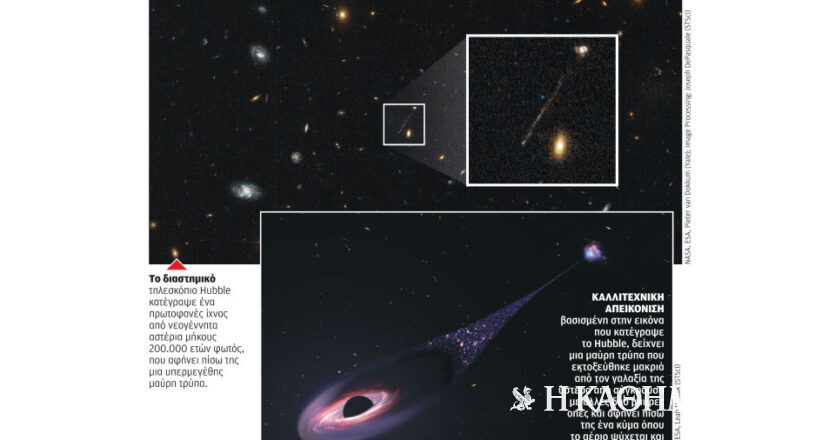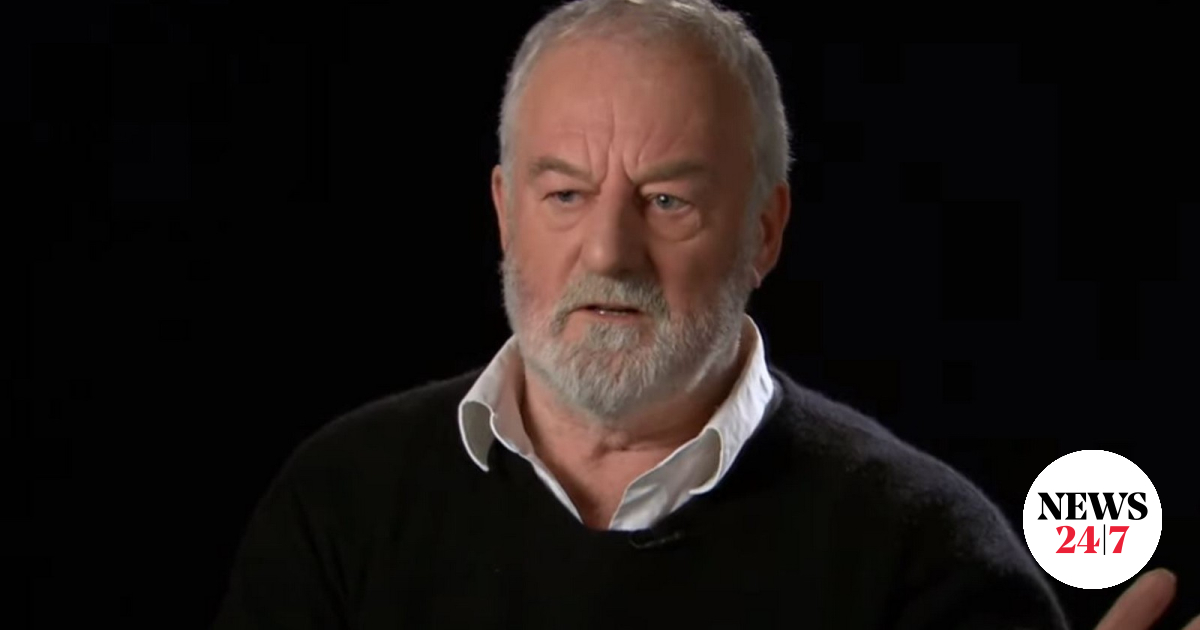
A supermassive black hole moving at an extremely high speed, leaving behind a fantastic and unprecedented trail of stars, has been recorded by the oldest Hubble Space Telescope, causing a sensation in the scientific community and igniting controversy. It is a supermassive black hole, which is moving away from its galaxy at a speed of 6.5 million kilometers per hour, so fast that it can go from Earth to the Moon in just 14 minutes. This speed is described as “amazing”, even for space.
“The more we observe the universe, the more new things we discover, the more it surprises us.” Ioannis Daglis tells K.Professor of Space Physics at Kapodistrian University in Athens and Head of the Hellenic Space Center, commenting on the international research team’s publication in the April issue of the journal Astrophysical Journal Letters.
“There are several interesting elements to this discovery. First, this particular black hole is very large, with a mass of 20 million times the mass of the Sun, when it is usually only a few times more massive than the Sun. The second distinguishing thing is its speed and how fast it is. In moving. As a result of this speed, instead of absorbing all the mass that it encounters in its path, it pushes a large part to the side. Like a boat moving in the sea rips through the water, collecting the mass of water to the right and left, “explains Mr. Daglis. “The result is that they cross and collect clouds of cosmic dust, collecting their mass in empty space. The local increase in mass density is the first step in star formation,” says the professor of space physics. As he notes, the path of star formation goes through the formation of clumps, concentrations of matter, and sequestration. over a critical density, induction of gravity, which leads to the emergence of protostars and then stars.
200,000 light years away
The researchers who followed the publication report an unprecedented trail of newborn stars 200,000 light-years across, left by the black hole. “We think we are seeing a wave behind the black hole, as the gas cools and is able to form stars. This is how we see star formation in the aftermath of the black hole,” said Peter van Dokkum, professor of astronomy and physics at Yale University and lead author of the study.
“arousing”
“Discovering that the motion of a supermassive black hole is causing the formation of new stars is something new,” says the head of the Hellenic Space Centre, Mr.
“This is a new perspective. The discovery that the motion of a supermassive black hole causes new stars to form is something new. Until now we knew that stars were born from explosions, when ‘fragments’ of celestial bodies were scattered into space and through a process coalesced into a new form. This is why In it it is exciting that black holes are associated with the creations of new stars,” notes Mr. Dauglis, especially since black holes are seen as aging stars.
There are also hypotheses about how this supermassive black hole acquired its very high speed. “Usually massive stars are in pairs. There might have been a system of two black holes, and when a third black hole approached it it spun away, perhaps receiving additional impetus from the other two,” explains Mr. Dauglis. Presentations by the research group are also used. Example of space billiards and how the ball can be thrown through a group of balls after a stroke.
glimpses into the past
“The universe never ceases to amaze me. It is horrible to think that what we see today does not exist. The more distant things are, the further back in time we go. When we look at the sky, we look into the past. For example, when we see the sun, we are looking Back eight minutes, because that’s the time it takes for light to come from the Sun to Earth. When we see Alpha Centauri, we see something that was there four years ago, “explains the head of the Greek Space Center.
It is noteworthy that it was the “old” Hubble Space Telescope that recorded this amazing phenomenon. According to Mr. Dauglis, Hubble is still worth the fight, while he notes that officials are also considering turning James Webb in the direction of the exact black hole. “What each telescope will see is also a matter of luck. It can notice in a certain direction as part of a reconnaissance and suddenly record something unexpected,” explains Mr. Dauglis. In fact, he tells us, there is an overabundance of requests in telescopes: because there are too many space research groups and proposal requests for observations, all of which cannot be satisfied, there is an allotment of time in the “look” of telescopes, so that it can be submitted as many as possible!
The field of research in space seems endless and challenging, as scientific knowledge for today and tomorrow is built through exciting dives into the deep past through observations of space telescopes.
algorithm contribution
Yesterday, an international scientific team published wonderful new images of the M87 black hole, with the participation of Greek astrophysicist Dimitris Psaltis, who works at the Georgia Institute of Technology in the United States of America. This is the result of reprocessing images and other data of the supermassive black hole at the center of the galaxy M87, also known as Messier 87 and A Virgo, collected in 2017 by the Event Horizon Telescope (EHT) collaboration. The research team first used PRIMO, a new algorithm that “learns” by feeding it large amounts of material from high-quality simulations of a black hole. The research team consisting of Lia Medeiros, Dimitris Psaltis, Tod R. Lauer, and Feryal Ozel noted that by taking advantage of a “properly trained” PRIMO, we can recover high-quality images of black holes, even in the presence of sparse coverage. PRIMO has reconstructed the remarkable image of the M87 supermassive black hole showing the familiar shape of black holes with a bright ring. Already in 2017, the EHT managed to record the first direct image of the center of the galaxy M87, where the monstrous black hole with a diameter of 40 billion km and a mass of 6.5 billion times the mass of the Sun is located. The exceptional resolution achieved by the EHT is made possible by an array of Earth-spanning telescopes whose images are merged. With the development of advanced algorithms, material recorded by telescopes can be visualized more efficiently.

“Total alcohol fanatic. Coffee junkie. Amateur twitter evangelist. Wannabe zombie enthusiast.”





More Stories
Everything Apple plans to reveal on May 7 at its iPad Let Loose event
Steps: How much to do for better health, weight loss, and wellness
USA: More than 200 paramilitary groups are organized via Facebook